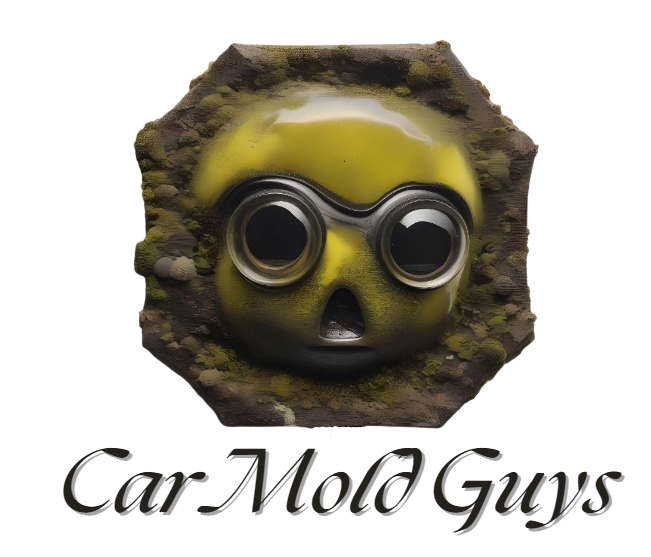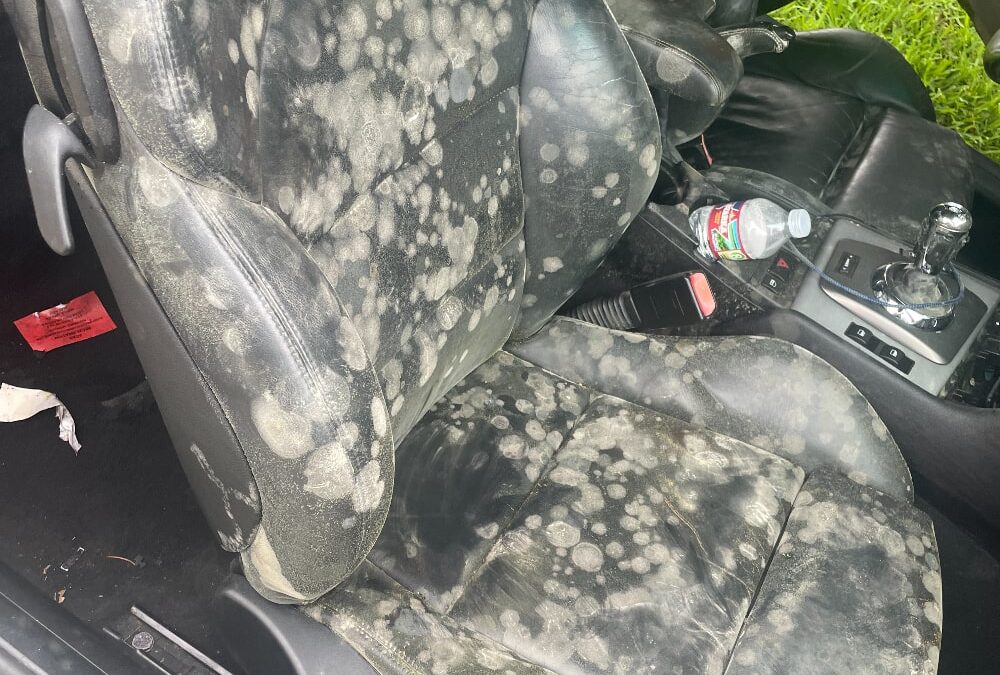Mold in cars is not just an unpleasant issue; it poses significant health risks and can cause extensive damage to your vehicle’s interior. Mold can develop from the accumulation of moisture in various parts of your car, such as the carpeting, seats, and even the HVAC system. This guide aims to provide a comprehensive solution for identifying, removing, and preventing mold in your car. We will cover the causes of mold, how to identify it, the step-by-step process for effective removal, and tips for maintaining a mold-free environment in your vehicle.
Identifying Mold in Your Car
Common Signs of Mold
Identifying mold in its early stages is crucial to prevent it from spreading and causing more significant problems. Here are some common signs of mold in your car:
- Musty Odor: A persistent, musty smell is often the first indicator of mold. This odor can be especially noticeable when you first enter the vehicle.
- Discoloration on Surfaces: Mold can appear as black, green, or white spots on your car’s interior surfaces, including seats, carpets, and door panels.
- Allergic Reactions: If you or your passengers experience allergic reactions such as sneezing, coughing, or watery eyes when inside the car, mold could be the culprit.
- Visible Mold Spots: Mold growth can sometimes be seen in areas where moisture accumulates, such as under seats, in the trunk, or around windows.
Health Risks Associated with Mold Exposure
Exposure to mold can lead to various health problems, especially for individuals with allergies, asthma, or weakened immune systems. The potential health risks include:
- Respiratory Issues: Mold spores can cause or exacerbate respiratory problems, including asthma attacks and bronchitis.
- Allergic Reactions: Common allergic reactions include sneezing, runny nose, itchy eyes, and skin rashes.
- Skin Irritation: Direct contact with mold can lead to skin irritation and rashes.
- Headaches: Inhaling mold spores can cause headaches and fatigue.
Areas in the Car Prone to Mold Growth
Mold can develop in several areas within your vehicle, particularly where moisture is likely to accumulate:
- Under Seats: Moisture can get trapped under the seats, making it a prime spot for mold growth.
- Carpets and Floor Mats: Spills and leaks can lead to damp carpets and floor mats, creating a breeding ground for mold.
- Door Seals: Damaged or worn-out door seals can allow water to seep into the car, leading to mold growth around the seals and in the door panels.
- Trunk Area: The trunk can trap moisture from wet items or leaks, making it susceptible to mold.
- Air Conditioning and Ventilation Systems: Mold can grow in the HVAC system, particularly if the car is not used frequently or if the system is not properly maintained.
Preparing for Mold Removal
Before starting the mold removal process, it’s essential to take certain precautions and gather the necessary tools and materials.
Safety Precautions
- Wear Protective Gloves and Masks: Mold spores can be harmful when inhaled or when they come into contact with your skin. Use rubber gloves and an N95 mask to protect yourself.
- Ensure Proper Ventilation: Work in a well-ventilated area to avoid inhaling mold spores and cleaning fumes. Open all doors and windows of the car.
- Keep Children and Pets Away: Ensure that children and pets are not present during the mold removal process.
Necessary Tools and Materials
To effectively remove mold from your car, gather the following tools and materials:
- N95 mask
- Rubber gloves
- Cleaning cloths
- Soft brush
- Vacuum cleaner with HEPA filter
- Mold removal cleaner (commercial or homemade)
- Baking soda
- White vinegar
- Spray bottle
- Dehumidifier
Ventilation and Workspace Setup
Proper ventilation is crucial when removing mold. Follow these steps to set up your workspace:
- Park the Car in a Well-Ventilated Area: Choose a location with good airflow, such as an open garage or driveway.
- Open All Doors and Windows: This will help dissipate mold spores and fumes from cleaning agents.
- Use Fans if Necessary: Place fans around the car to enhance air circulation and expedite the drying process.
Step-by-Step Mold Removal Process
Initial Inspection and Containment
- Identify All Mold-Affected Areas: Thoroughly inspect your car to locate all areas with mold growth. Pay special attention to hidden spots like under seats and in the trunk.
- Remove and Dispose of Any Heavily Contaminated Materials: If you find items that are heavily infested with mold, such as floor mats or seat covers, it’s best to dispose of them and replace them with new ones.
Cleaning Interior Surfaces
- Vacuum All Surfaces with a HEPA Filter Vacuum: Start by vacuuming the entire interior of your car using a vacuum cleaner equipped with a HEPA filter. This will help capture mold spores and prevent them from becoming airborne.
- Use a Mold Removal Cleaner or a Mixture of White Vinegar and Water: Fill a spray bottle with a solution of white vinegar and water (1:1 ratio) or use a commercial mold removal cleaner. Spray the affected areas generously.
- Scrub with a Soft Brush: Use a soft brush to scrub the moldy surfaces. Be gentle to avoid damaging the materials.
- Wipe Clean with a Damp Cloth: After scrubbing, wipe the surfaces with a damp cloth to remove any remaining mold and cleaning solution.
Cleaning HVAC System
- Replace the Cabin Air Filter: A moldy cabin air filter can spread spores throughout your car. Replace it with a new one.
- Use a Mold Cleaner Spray for HVAC Systems: There are specific mold cleaners designed for HVAC systems. Follow the product instructions to treat your car’s air conditioning and ventilation system.
- Run the Air Conditioning on High: Turn on the air conditioning system on high with the cleaner applied to the intake to help disinfect the system.
Dehumidifying the Car
- Use a Dehumidifier Inside the Car: Place a dehumidifier inside the car and run it for several hours. This will help remove excess moisture from the air and dry out the interior surfaces.
- Ensure All Surfaces Are Completely Dry: Mold thrives in damp environments, so it’s crucial to make sure that all surfaces are thoroughly dried.
Preventing Future Mold Growth
- Regularly Clean and Vacuum the Interior: Maintain a regular cleaning schedule to prevent mold from gaining a foothold. Vacuum the interior and wipe down surfaces with disinfectant wipes.
- Use Moisture-Absorbing Products: Consider placing moisture-absorbing products like silica gel packs or activated charcoal in your car to keep humidity levels low.
- Fix Any Leaks Immediately: Inspect your car for leaks and address them promptly to prevent water from accumulating.
- Keep Windows Slightly Open to Promote Airflow: When parked, keep the windows slightly open to allow for air circulation, especially in hot and humid climates.
DIY vs. Professional Mold Removal
Pros and Cons of DIY Mold Removal
Pros:
- Cost-Effective: DIY mold removal can save you money compared to hiring professional services.
- Immediate Action: You can address the mold problem as soon as you notice it without waiting for an appointment.
Cons:
- May Not Completely Remove Mold: Without proper equipment and expertise, you might not be able to remove all mold spores, leading to recurrence.
- Potential Health Risks: Handling mold without proper protective gear and techniques can pose health risks.
- Mold removal companies will be able to identify the root cause of the mold source, and able to clear clogged seals, and ensure the integrity of moisture control.
When to Consider Professional Mold Removal Services
- Extensive Mold Growth: If mold has spread extensively throughout your car, professional help is recommended.
- Recurrent Mold Issues: Persistent mold problems may indicate underlying issues that require professional assessment and treatment.
- Health Concerns: If you or your passengers have health conditions that could be exacerbated by mold, it’s best to seek professional assistance.
Maintaining a Mold-Free Car
Regular Cleaning Tips
- Vacuum Regularly: Keep your car clean by vacuuming the interior frequently to remove dirt and debris that can contribute to mold growth.
- Use Disinfectant Wipes on Surfaces: Wipe down surfaces with disinfectant wipes to kill mold spores and prevent buildup.
- Use the Best Mold Cleaning Products (hydrogen peroxide, chlorine dioxide, etc.) In addition, there are many remediation cleaning products available in the market that can effectively remove mold from your car. Look for a product that is specifically designed for mold removal and follow the instructions carefully. Avoid using bleach or other harsh chemicals, as they can damage your car’s interior.
- Clean Spills Immediately: Address spills promptly to prevent moisture from seeping into carpets and upholstery.
Monitoring Moisture Levels
- Use a Hygrometer to Check Humidity Levels: A hygrometer can help you monitor the humidity levels in your car. Aim to keep humidity below 60% to inhibit mold growth.
- Keep the Interior Dry: Ensure that all surfaces are dry, especially after cleaning or during humid weather.
Mold Prevention Measures
- Regularly Inspect for Leaks: Check for leaks around windows, sunroofs, and door seals. Repair any leaks promptly to prevent water from entering the car.
- Use Sunshades to Reduce Heat and Humidity: Sunshades can help lower the temperature inside your car, reducing the risk of mold growth.
- Park in Well-Ventilated Areas: Whenever possible, park your car in a well-ventilated area to promote airflow and prevent moisture buildup.
Conclusion
Addressing mold in your car promptly and effectively is crucial for your health and the longevity of your vehicle. Mold not only affects the aesthetic and comfort of your car but also poses significant health risks. By identifying mold early, using proper cleaning techniques, and maintaining a clean and dry environment, you can ensure a mold-free car. Regular inspections, immediate attention to spills and leaks, and the use of preventive measures are key to keeping your car safe and comfortable. By following this comprehensive guide, you can effectively remove mold from your car and prevent it from returning, ensuring a clean, safe, and pleasant driving experience.

